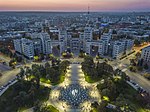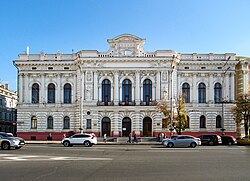Kharkiv National Academic Opera and Ballet Theatre

The Kharkiv State Academic Opera and Ballet Theatre was a theater in Kharkiv, Ukraine. It was heavily damaged and possibly destroyed in March 2022 during the Battle of Kharkiv (2022) in the ongoing 2022 Russian invasion of Ukraine when Russian forces attacked Freedom Square. The postmodern theater building was built in 1991 and featured tufa tiles. A student-led study at the Kharkiv School of Architecture found that the theater was considered a "community hub" and that the exterior was popular with skateboarders.Notable performances at the venue include a 2019 production of the ballet Swan Lake, choreographed by Johan Nus, which used 42 tons of water. On December 23, 2020, the opera house was the site of the funeral for Kharkiv mayor Hennadii Kernes.
Excerpt from the Wikipedia article Kharkiv National Academic Opera and Ballet Theatre (License: CC BY-SA 3.0, Authors, Images).Kharkiv National Academic Opera and Ballet Theatre
Sumska Street, Kharkiv Сокольники
Geographical coordinates (GPS) Address External links Nearby Places Show on map
Geographical coordinates (GPS)
| Latitude | Longitude |
|---|---|
| N 49.9991 ° | E 36.2323 ° |
Address
Харківський національний академічний театр опери та балету імені Миколи Лисенка (ХНАТОБ) (ХАТОБ)
Sumska Street 25
61000 Kharkiv, Сокольники
Kharkiv Oblast, Ukraine
Open on Google Maps









